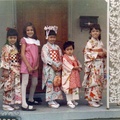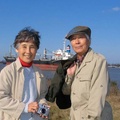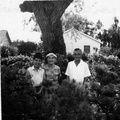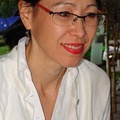Read Part 2 >>
Izumi family:
Like the Yenaris, the Izumis were interned in Rohwer and were one of the last families to leave camp. Mr. Izumi was in the newspaper business and could not find work after the war had ended. With few options, he moved his family to New Orleans. Eventually, Mr. Izumi met a man named C. D. Hoi, a Chinese businessman who hired him to sell shrimp.1 Although neither spoke the other's language, they communicated by writing everything in Chinese characters.
The Izumi's daughter, Setsuko, was a teenager at the time and recalls her years in New Orleans as the happiest of her life. She attended high school, and later studied at Loyola University of New Orleans during the 1950s. Although most people had no idea where Japan was, and had no concept of Japanese Americans, they were friendly and helpful.
She recalls that there were no businesses that catered to Japanese, so everything had to be made from scratch.4 Tofu, for instance, did not exist in New Orleans at the time, so the community pooled their resources and knowledge to help one another. Mr. Daisuke Yenari knew how to generate the mold. A local pharmacist carried calcium chloride needed to solidify the soybeans, and Mrs. Izumi then made the tofu which was shared by all. If they needed other Japanese ingredients, they generally had to grow them in their own gardens.
Setsuko-san recalled the small social network of Japanese and Japanese Americans during those years. Nikkei students attending Tulane University visited for her mother’s home cooked Japanese food, as there were no Japanese restaurants at the time. Her father enjoyed having people over to play mahjong on Friday nights.
Among those friends was Mr. Iimura, the first Japanese sent to New Orleans as a part of the JETRO (Japan External Trade Organization) program. Like the many Japanese nationals who followed, he found comfort in socializing with other Japanese speakers during his stay. Setsuko-san also remembered another mahjong regular was Mr. Teddy Iwai, an Issei chick sexer who learned English solely by watching American television; he met his Nisei wife through these parties.
When they raised enough money, the Izumi family eventually moved back to Los Angeles. However, this was not before the senior Izumi passed away. Being Buddhist, the Izumi family, like many other Nikkei families, had to contact the nearest Japanese Buddhist priest from Chicago to carry out funereal rites. However, since the State of Louisiana did not allow cremation at the time, bodies of the deceased were sent to Memphis, tennessee to have this service carried out.2
The Izumi family continued to maintain contact with New Orleans Nikkei friends. When they returned for visits, they were often greeted by Nikkei friends with piles of boiled Louisiana seafood and a pot of gumbo.
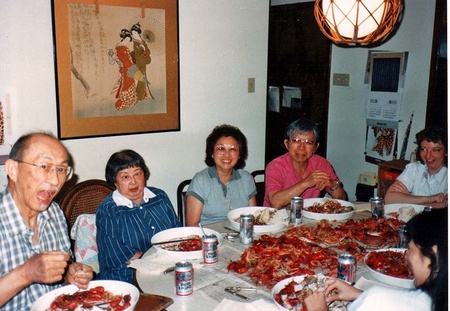
1989; The Yenari family enjoying boiled Louisiana seafood and beer with returning Nikkei friends. L-R Mr. Hajime Yenari, Mrs. Katsu Yenari, Mrs. Setsuko Asano (nee Izumi), Mr. Koi Asano, Mrs. Kellie Yenari, Ms. Midori Yenari
Okubo family:
Mr. Okubo, an Issei truck farmer from Gardena, California, moved his large family to New Orleans. Unlike Mr. James Imahara, Mr. Okubo knew little English and had a difficult time finding work and making enough money to support his large family. He would find menial work, but had a hard time communicating with his employers and co-workers.
His daughter Dolly recalled that farming was his true passion, and he raised vegetables and pecan trees on his property along the banks of the Mississippi River in suburban New Orleans. He often called on fellow Nikkei friends, and he could always be counted on to bring a generous sack of his own Chayote squash (called mirlitons, in the local parlance) or Chinese long beans. Despite difficult times, his children went on to attend college. His daughter Dolly worked as a hospital administrator and served as secretary for the local Japan Society.
Yatsu family:
Dr. Larry Yatsu always had a way with kids. He told the corniest jokes and kept otherwise mischievous children entertained at various social events. One would have never guessed that this comedian was a university science professor and an accomplished man of letters.
A native of Pasadena, California, Dr. Yatsu was interned in Poston, Arizona where the summers were blazing hot and the barracks heated up to over 100 degrees. Dr. Yatsu was one of many Nisei who were drafted during the war years. He served in the now famous all Nisei 442nd Infantry. In fact, he is the only 442nd Veteran in the New Orleans area.
After the war, he attended school on the GI bill and earned his doctorate at Cornell University. There, he met and married Terry Yatsu, and the two moved to Bogalusa, Louisiana in 1960 where he worked as a researcher for the USDA. Later, he taught at Tulane University with expertise in electron microscopy, He finally moved to Southern University of New Orleans where he was a professor of chemistry.
Dr. and Mrs. Yatsu, like many New Orleanians, were victims of flooding following Hurricane Katrina. Although he had safely evacuated to Seattle to stay with his daughter, he lost all material goods. Of course, having lived through some of the most difficult times in US history, he managed to start all over again and remains in New Orleans while his grandson attends a prestigious local high school. Certainly, the Yatsu family is an example of what Nikkei take great pride in, and that is endurance and perseverance summed up in a single word: ‘gaman.’
Notes:
1. Morimitsu G. A package of dried shrimp. Scene 1949;Dec.:44-46.
2. Asano, S. Legacies of the Issei and Nisei, in Nanka Nikkei Voices: The Japanese American Family, Japanese American Historical Society of Southern California (2010) 123-5
© 2012 Midori Yenari & Anna Stahl



